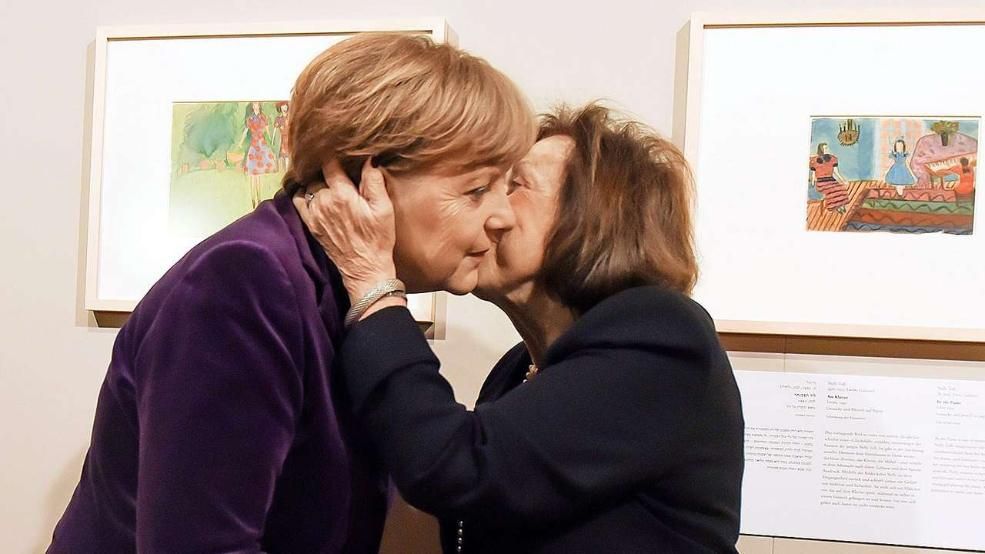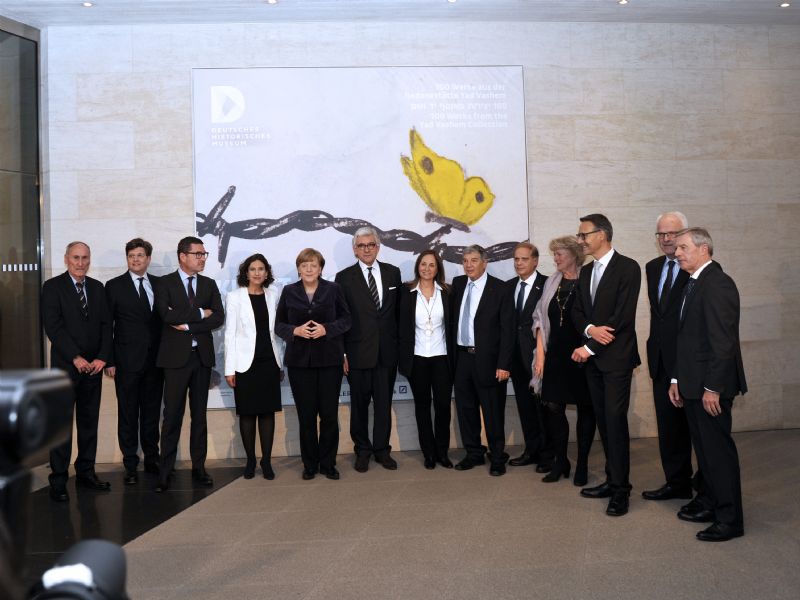_0.jpg?itok=30sYoxld)
German Chancellor Angela Merkel and Prime Minister Netanyahu tour the new exhibition of Yad Vashem artworks currently on display in Berlin
For more pictures click here
16 February 2016
Accompanied by German Chancellor Angela Merkel, Israel's Prime Minister Benjamin Netanyahu and his wife Sara visited a new exhibition of Yad Vashem artworks currently on display at the German Historical Museum in Berlin. Jointly curated by Yad Vashem and the Bonn-based Foundation for Art and Culture, "Art from the Holocaust: 100 Works from the Yad Vashem Collection" is the first-ever art exhibition of its size and stature that Yad Vashem has sent abroad. The exhibition, which attracted close to 12,000 visitors in its first two weeks and led to the extension of opening hours at the Museum, will be on display until 3 April 2016.
Chancellor Merkel opened the exhibition on 25 January, the week of International Holocaust Remembrance Day, in the presence of Yad Vashem Chairman Avner Shalev; German Federal Minister for Culture and Media Prof. Dr. Monika Grütters; Prof. Dr. Alexander Koch, President of the German Historical Museum; Prof. Dr. Walter Smerling, Chairman of the Foundation for Art and Culture and Curator of the Exhibition; Vivian Uriah, Director of Yad Vashem's Museums Division; Eliad Moreh-Rosenberg, Director of Yad Vashem's Art Department and Curator of the Exhibition; Dr. Jürgen Rüttgers, Chairman of the Society of Friends of Yad Vashem in Germany; and Kai Diekmann, Publisher of BILD Group and Board Member of the Foundation for Art and Culture. Also present were Holocaust survivors, including Nelly Toll, the only surviving artist of the 50 represented in the exhibition. Half of the artists were murdered during the Holocaust.
The works meticulously selected from Yad Vashem's Art Collection - the largest of its kind in the world, with almost 10,000 artworks - were all created between 1939 and 1945, as events were unfolding and the artists experienced them first-hand. Created under the harshest of circumstances, the artworks testify to the power of the human spirit that refused to surrender. Some of the creations displayed express a tremendous struggle with the surrounding, horrific reality - themes of banishment, deportation, the ghetto and the camp are clearly identifiable - while others indicate a desperate flight into the realm of imagination, with depictions of landscapes, skylines, homes and religious faith. Portraits also feature prominently - an attempt by artists to memorialize their brethren and draw their own portraits as they would like to be remembered by future generations - not as victims, but as human beings.
"Through art we can feel the power and the suffering of human beings," said Chancellor Merkel during the opening event.
"The paintings are a warning for us, each one in its own way: What happened is not to be forgotten, the memory of the victims has to be kept and we have to do everything with all our power so that it won't happen again."
"The artworks we chose for this exhibition constitute rare human testimony," explained Yad Vashem Chairman Avner Shalev. "They cry out with the greatest sensitivity; at once naive, trusting and prayerful, while also realistic and insightful. They provide a unique expression to the spirit of humankind, as it confronted unexplained human immorality. Such a confrontation through creative expression awakens us to reflection and soul-searching; the visitors to this exhibition will be exposed to creative sparks of humanity, and will come away with those sparks to illuminate their way."
President of the German Historical Museum Alexander Koch stated: "That these paintings somehow survived till today is a treasure, one that has not lost any of its significance."
Kai Diekmann, Board Member of the Foundation for Art and Culture and Editor-in-Chief of the national daily BILD media partner, recalled how during one of his visits to Yad Vashem he realized that he wanted to show "these deeply touching artworks in Germany... In the tradition of Axel Springer, who have always supported the reconciliation between Jews and Germans, I hope that art can help to rebuild destroyed bridges."
A selection of the artworks featured in the exhibition may be viewed on Yad Vashem's website.
_0.jpg)
Photo courtesy Bundesregierung/ Steffen Kugler
_0.jpg?itok=AsInW77L)


_0.jpg)
DHM/Wolfgang Siesing
_0.jpg?itok=u_5K6AIk)
_0.jpg)
DHM/Wolfgang Siesing
_0.jpg?itok=Sq7GFueX)
_0.jpg)
DHM/Wolfgang Siesing
_0.jpg?itok=DIJLb0-0)
_0.jpg)
DHM/Wolfgang Siesing
_0.jpg?itok=HxXMtnDN)
_0.jpg)
DHM/Wolfgang Siesing
_0.jpg?itok=LuT-26Sq)

Left to right: Director of the German-Speaking Countries and German Swiss Desk, Yad Vashem International Relations Division, Arik Rav-On; Daimler AG Representative Eckart von Klaeden; Kai Diekmann; Eliad Moreh-Rosenberg; H.E. Angela Merkel, Prof. Dr. Walter Smerling; Director of the Yad Vashem Museums and Visitor Services Division Vivian Uriah; Avner Shalev; Israeli Ambassador to Germany H.E. Yakov Hadas-Handelsman; Prof. Dr. Monika Grutters; Prof. Dr. Alexander Koch; Chairman of the Society of Friends of Yad Vashem in Germany Dr. Juergen Ruettgers; Deutsche Bank AG Representative Juergen Fitschen.
Photo courtesy Bundesregierung/ Guido Bergmann

(2)_0.jpg)
(2)_0.jpg?itok=qWtYzY-M)






